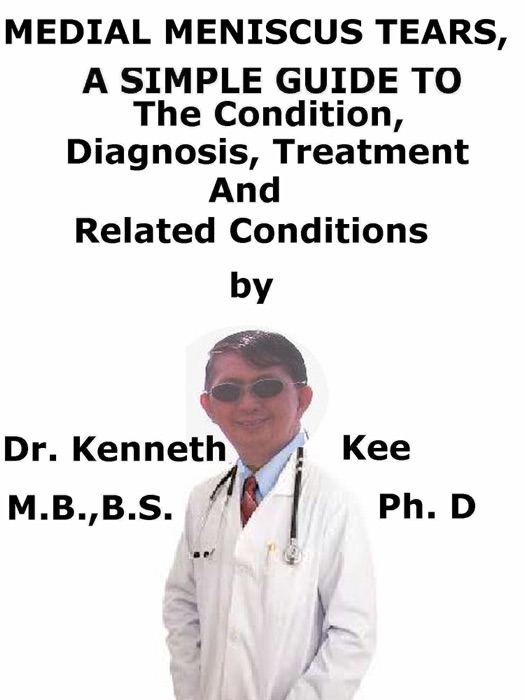(DOWNLOAD) "Medial Meniscus Tears, A Simple Guide To The Condition, Diagnosis, Treatment And Related Conditions" by Kenneth Kee # eBook PDF Kindle ePub Free

eBook details
- Title: Medial Meniscus Tears, A Simple Guide To The Condition, Diagnosis, Treatment And Related Conditions
- Author : Kenneth Kee
- Release Date : January 06, 2019
- Genre: Medical,Books,Professional & Technical,
- Pages : * pages
- Size : 139 KB
Description
This book describes Medial Meniscus Tears, Diagnosis and Treatment and Related Diseases
Meniscus tears are the medical injuries in the shock-absorbing cartilage (meniscus) of the knee.
The meniscus is a C-shaped piece of cartilage sited in the knee.
There is a medial meniscus and lateral meniscus in each knee.
They have a vital role in protecting the cartilage in the knee stability.
Menisci are structures composed of fiber cartilage located between the femur and the tibia.
This cartilage is found in certain joints and acts as a buffer between the bones to protect the joint.
The meniscus:
1.Works like a shock-absorber
2.Helps distribute the weight to the cartilage
3.Helps to stabilize the knee joint
4.Assists in lubricating the knee joint
5.Can restricts the ability to flex and extend the knee
The medial tear meniscus (or internal) is a very frequent disorder that also happens well after a sports injury that are due to daily strenuous movements (squat pivot or twist) or degeneration.
The medial meniscus tears are 5 times more frequent than injuries of the lateral meniscus.
The medial meniscus tear is not just a sports injury but can also occur in daily life or professional employment such as kneeling or squatting in construction workers and plumbers).
Torn meniscus, especially medial meniscus may be accompanied by articulate cartilage ligament injuries.
Causes
A medial meniscus tear can happen if the patient:
1.Twists or over-flexes the knee
2.Quickly stops moving and change direction while running, landing from a jump, or turning
3.Kneels down
4.Squats down low and lift something heavy
5.Gets hit on the knee, such as during a football tackle
As the patient get older, the medial meniscus ages too, and it can become easier to injure.
Tears or ruptures of the medial meniscus are often the effect of a traumatic rotation or in a squat in high flexion.
Symptoms
The pain is located at the knee, between the tibia and femur (termed internal tibio-femoral compartment of the knee), and occur during and after physical activity or squatting.
The pain may be intermittent, annoying, or spontaneously without any history of trauma.
1.The patient might feel a "pop" when the patient tears a medial meniscus.
2.Most people can still walk on their injured knee.
3.Many athletes keep playing with a tear.
4.Over 2 to 3 days, the knee will gradually become more stiff and swollen
Diagnosis:
One main test for meniscus tears is called the McMurray test.
The patient lie on the back while the doctor holds the heel of the injured leg with the leg bent.
The doctor will then straighten the knee and rotate it.
This puts tension on a torn meniscus.
Pressure is applied to the knee while the leg is rotated in and out to produce discomfort or pain.
A complaint of pain or a click over the inner part of the joint indicates an inner (medial) meniscus tears.
If the patient has a meniscus tear, this movement will cause a painful click.
MRI will show if there are medial meniscus tears.
Treatment
If the patient has a meniscus tear, the patient may need:
1.Crutches to walk until the swelling and pain get better
2.A brace to support and stabilize the knee
3.Physical therapy to help improve joint motion and leg strength
4.Surgery to repair or remove the torn meniscus
Knee arthroscopy is done if non-operative methods do not work:
a.Partial meniscectomy
b.Meniscus repair
c.Meniscus transplantation
Treatment may depend on the age, activity level, and where the tear happens
Conservative treatment:
1.Rest, ice and elevation
2.Compression bandaging
3.Pain killers such as NSAID to stop pain
4.Muscle relaxants
5.Steroid injections for inflammation
6.Physiotherapy
TABLE OF CONTENT
Introduction
Chapter 1 Medial Meniscus Tears
Chapter 2 Causes
Chapter 3 Symptoms
Chapter 4 Diagnosis
Chapter 5 Treatment
Chapter 6 Prognosis
Chapter 7 Articulate Cartilage Disease
Chapter 8 Dislocated Knee cap
Epilogue
Free PDF Download "Medial Meniscus Tears, A Simple Guide To The Condition, Diagnosis, Treatment And Related Conditions" Online ePub Kindle
- (DOWNLOAD) "Mediation im Klassenzimmer" by Hansueli Weber * eBook PDF Kindle ePub Free
- (Download) "Finding a Heart of Snow" by Ian Sentelik # eBook PDF Kindle ePub Free
- (DOWNLOAD) "Media Use and Internalized Weight Stigma in a Weight Loss Treatment-Seeking Sample" by Jacob M. Burmeister * eBook PDF Kindle ePub Free
![[DOWNLOAD]](http://is4-ssl.mzstatic.com/image/thumb/Publication115/v4/b8/6d/51/b86d51eb-cc87-cee0-13c8-8b2e037075ce/source/700x700bb.jpg)

![[DOWNLOAD]](http://is2-ssl.mzstatic.com/image/thumb/Publication118/v4/0a/74/ae/0a74ae97-6caf-33a8-8e8d-574092068c87/source/700x700bb.jpg)
![[DOWNLOAD]](http://is2-ssl.mzstatic.com/image/thumb/Publication69/v4/3c/69/e2/3c69e2b3-148b-8ae3-339d-867b326e59c1/source/700x700bb.jpg)